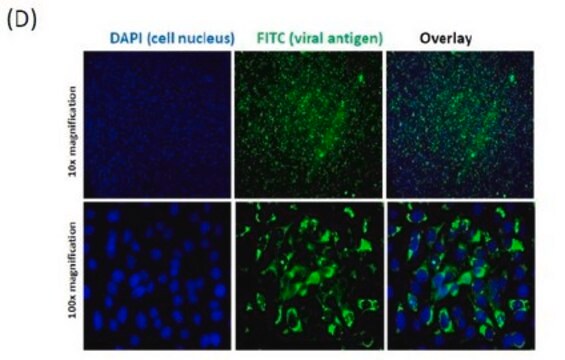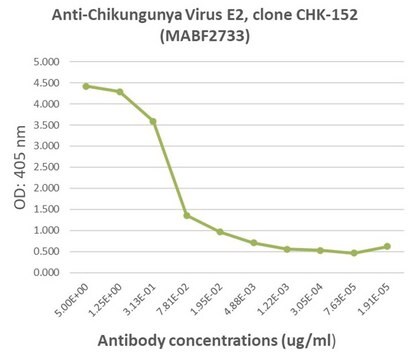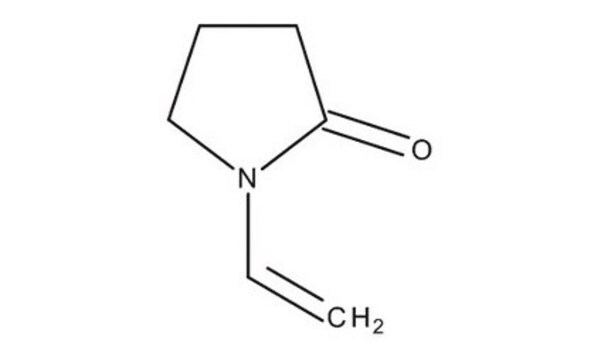MABF2052
Anti-Chikungunya virus Antibody, clone 3E7b
clone 3E7b, from mouse
Synonym(s):
CHIKV
Sign Into View Organizational & Contract Pricing
All Photos(1)
About This Item
UNSPSC Code:
12352203
eCl@ss:
32160702
Recommended Products
biological source
mouse
antibody form
purified immunoglobulin
antibody product type
primary antibodies
clone
3E7b, monoclonal
species reactivity
virus
packaging
antibody small pack of 25 μL
technique(s)
ELISA: suitable
immunocytochemistry: suitable
neutralization: suitable
western blot: suitable
isotype
IgMκ
target post-translational modification
unmodified
General description
Chikungunya virus (CHIKV) that causes distinctive polyarthritis or polyarthralgia with clinical features such as fever, maculopapular rash, and myalgia is transmitted by Aedes spp of mosquitoes. Immune compromised individuals may face serious complications, including encephalitis and mortality. CHIKV genome contains a single-stranded positive-sense RNA that encodes four non-structural proteins known as nsP1, nsP2, nsP3, and nsP4 and also five structural proteins that include a capsid protein, three envelope glycoproteins known as (E1, E2, and E3, and a small molecule known as 6K. The mature alphavirus particles express E1 and E2 heterodimers that form 80 trimeric spikes on the surface of the virion. The ectodomain E1 protein consists of three domains known as D1, DII, and DIII. The DIII domain is an immunoglobulin-like domain connected to D1 and DII by a flexible linker. Both E1 and E2 proteins are responsible for virus entry into host cells. The E2 glycoprotein interacts with a cellular receptor, resulting in the virus internalization and the E1 glycoprotein mediates virus fusion to host cell under low pH conditions. Following the fusion of the viral envelope with the endosomal membrane, the viral genomic RNA is released into the cytoplasm and starts replicating. This monoclonal antibody (3E7b) can bind strongly to native CHIKV surface and potently neutralize virus replication (Ref.: Marsinoul, P., et al. (2014). Virology 464-465; 111-117; Lam, S., et al. (2015). mAbs 7(6), 1178-1194).
Specificity
Clone 3E7b detects Chikungunya virus in cells infected with this virus.
Immunogen
Chikungunya virus
Application
Anti-Chikungunya virus, clone 3E7b, Cat. No. MABF2052, is a mouse monoclonal antibody that detects E2 protein of Chikungunya virus and has been tested for use in ELISA, Immunocytochemistry, Neutralizing asssay, and Western Blotting.
Research Category
Inflammation & Immunology
Inflammation & Immunology
Western Blotting Analysis: A representative lot detected Chikungunya virus in Western Blotting applications (Lam, S., et. al. (2015). MAbs. 7(6):1178-94).
Immunocytochemistry Analysis: A representative lot detected Chikungunya virus in Immunocytochemistry applications (Lam, S., et. al. (2015). MAbs. 7(6):1178-94).
Immunocytochemistry Analysis: A 1:100 dilution from a representative lot detected Chikungunya virus in BHK cells infected with Chikungunya virus. (Courtesy from an independent lab).
Neutralizing Analysis: A representative lot neutralized Chikungunya virus in Neutralizing applications (Lam, S., et. al. (2015). MAbs. 7(6):1178-94).
ELISA Analysis: A representative lot detected Chikungunya virus in ELISA applications (Lam, S., et. al. (2015). MAbs. 7(6):1178-94).
Immunocytochemistry Analysis: A representative lot detected Chikungunya virus in Immunocytochemistry applications (Lam, S., et. al. (2015). MAbs. 7(6):1178-94).
Immunocytochemistry Analysis: A 1:100 dilution from a representative lot detected Chikungunya virus in BHK cells infected with Chikungunya virus. (Courtesy from an independent lab).
Neutralizing Analysis: A representative lot neutralized Chikungunya virus in Neutralizing applications (Lam, S., et. al. (2015). MAbs. 7(6):1178-94).
ELISA Analysis: A representative lot detected Chikungunya virus in ELISA applications (Lam, S., et. al. (2015). MAbs. 7(6):1178-94).
Quality
Isotype testing: Identity Confirmation by Isotyping Test.
Isotype Analysis: The identity of this monoclonal antibody is confirmed by isotype test to be mouse IgMk.
Isotype Analysis: The identity of this monoclonal antibody is confirmed by isotype test to be mouse IgMk.
Physical form
Format: Purified
Purified mouse monoclonal antibody IgM in PBS without azide.
Storage and Stability
Stable for 1 year at -20°C from date of receipt. Handling Recommendations: Upon receipt and prior to removing the cap, centrifuge the vial and gently mix the solution. Aliquot into microcentrifuge tubes and store at -20°C. Avoid repeated freeze/thaw cycles, which may damage IgG and affect product performance.
Other Notes
Concentration: Please refer to lot specific datasheet.
Disclaimer
Unless otherwise stated in our catalog or other company documentation accompanying the product(s), our products are intended for research use only and are not to be used for any other purpose, which includes but is not limited to, unauthorized commercial uses, in vitro diagnostic uses, ex vivo or in vivo therapeutic uses or any type of consumption or application to humans or animals.
Not finding the right product?
Try our Product Selector Tool.
Certificates of Analysis (COA)
Search for Certificates of Analysis (COA) by entering the products Lot/Batch Number. Lot and Batch Numbers can be found on a product’s label following the words ‘Lot’ or ‘Batch’.
Already Own This Product?
Find documentation for the products that you have recently purchased in the Document Library.
Our team of scientists has experience in all areas of research including Life Science, Material Science, Chemical Synthesis, Chromatography, Analytical and many others.
Contact Technical Service







